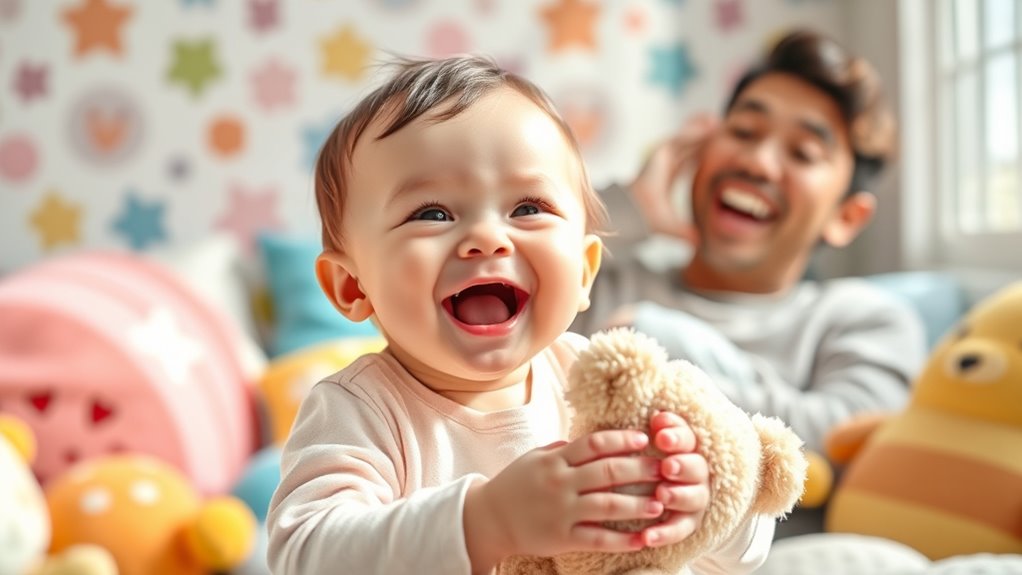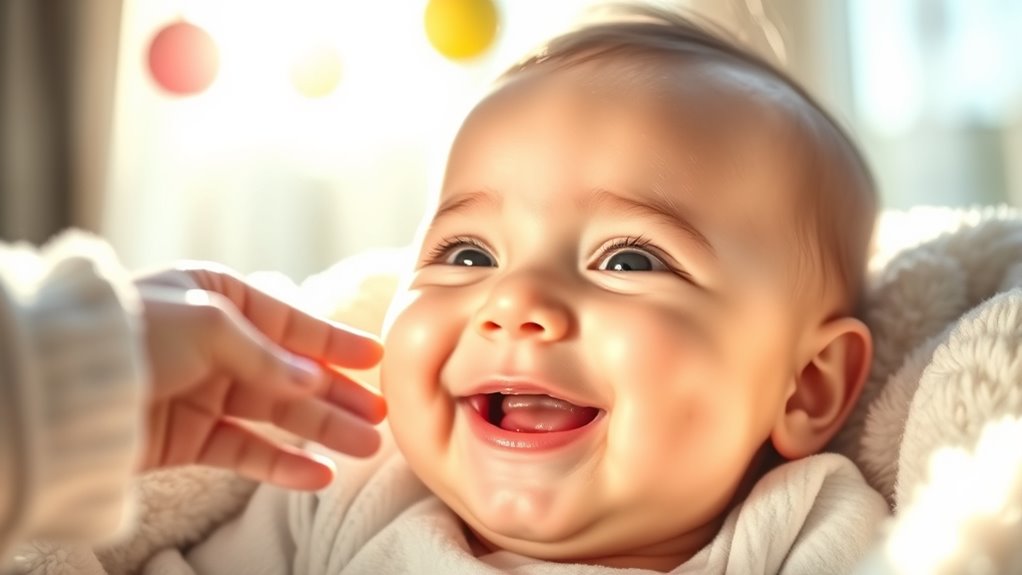To encourage your baby’s laughter, engage in playful activities like peekaboo and tickling, as these can elicit giggles. Make silly faces and sounds to stimulate their senses and spark joy. Remember, your full attention is key in creating a bond and promoting social interactions. Each laugh not only enhances your connection but also helps your baby express their emotions. Keep the fun going, and you’ll discover even more ways to enhance those precious moments together.
Key Takeaways
- Engage in classic games like peekaboo to stimulate laughter through surprise and interaction.
- Use tickling around 6 months to create joyful and playful moments that elicit giggles.
- Make silly faces and funny sounds to encourage your baby to respond with laughter.
- Provide full attention during playtime to strengthen the bond and promote positive responses.
- Incorporate sensory activities during tummy time to enhance stimulation and laughter opportunities.

Encouraging your baby to laugh can be a delightful experience that strengthens your bond and enhances their emotional development. You’ll notice that babies typically start giggling around 3 to 4 months and laugh out loud by 6 months. This laughter isn’t just something cute to enjoy; it’s a significant milestone indicating your baby’s cognitive growth and budding communication skills. Remember, every baby develops at their own pace, so don’t worry if your little one starts laughing a bit later than others.
Engaging with your baby through play is one of the best ways to encourage laughter. Classic games like peekaboo are universally loved and can elicit giggles from even the most serious little ones. You’ll likely find that your baby laughs more when you’re actively involved, so take the time to connect with them.
Tickling is another excellent method that works particularly well around 6 months. The joy of sensory stimulation, like during tummy time, can also lead to those precious laughs. Making funny faces and silly sounds is a surefire way to bring a smile to your baby’s face, so don’t hold back.
Social interaction plays a crucial role in encouraging laughter. Babies respond positively when they receive your full attention. This bond strengthens through laughter, helping your little one feel included and understood. As they laugh, they’re also learning about social cues and cause and effect. You’ll see how they begin to recognize the connection between their actions and your reactions, enhancing their overall cognitive development. Additionally, creating a responsive environment can significantly boost their emotional well-being and laughter.
When your baby laughs, it’s not just a sign of happiness; it’s also a way for them to express emotions. As they engage with you, they’re building a responsive environment that encourages further laughter. You can support this by mimicking their sounds and vocalizations, which creates a playful atmosphere. Each laugh from your baby helps you both to develop a deeper emotional connection, turning parenting into a joyful experience.
You’ll find that laughter isn’t just beneficial for your baby; it’s also a natural stress reliever for you. Creating moments of joy through laughter can foster a positive feedback loop, enhancing both your well-being and your baby’s development.
In this wonderful journey of parenthood, each laugh becomes a cherished memory, making your interactions more enjoyable and fulfilling. So go ahead, embrace the silliness, and watch your baby’s laughter light up your world.
Frequently Asked Questions
What Age Do Babies Typically Start Laughing?
Babies typically start laughing between 3 to 4 months old. At this age, you might notice them giggling instead of full laughs.
Each baby develops at their own pace, so some may start earlier or later. Pay attention to your little one’s cues; you’ll see them respond to playful interactions or gentle touches.
This laughter is a crucial milestone, indicating their emotional and social growth as they begin to connect with the world around them.
Is There a Difference Between Giggles and Belly Laughs?
You might say giggles and belly laughs are like two delightful cousins at a family reunion.
Giggles are those sweet, high-pitched chuckles that tickle the air, often popping up around 3 to 4 months old. Belly laughs, on the other hand, are the hearty, joyful roars that come later, reflecting true amusement.
While giggles can be sparked by playful antics, belly laughs often burst forth from genuine surprises. Both create special moments together!
How Can I Tell if My Baby Is Happy?
You can tell if your baby is happy by observing their smiles and laughter, which are clear signs of joy.
Look for a relaxed posture and playful engagement with toys or people. When your baby makes cooing sounds or maintains eye contact, they’re likely feeling content.
Also, notice their movements; if they’re wiggling their arms and legs, it’s a good indicator that they’re excited and enjoying their surroundings.
Do Certain Toys Promote Laughter More Than Others?
Absolutely, certain toys can promote laughter more than others.
For example, imagine your baby’s delight when a pop-up toy surprises them with a cheerful character. That unexpected movement sparks joy and giggles!
Toys with sensory elements like textured surfaces or sound-making features can also evoke laughter, as they engage your baby’s curiosity and senses.
Can a Baby’s Laughter Indicate Developmental Milestones?
Yes, a baby’s laughter can indicate developmental milestones. As you observe your little one giggling, it’s a sign they’re developing social awareness and emotional intelligence.
Laughter typically emerges around three to four months, reflecting cognitive growth and understanding of cause and effect. When they respond to playful interactions, they’re also enhancing their communication skills.
Conclusion
Encouraging your baby to laugh is like planting seeds in a garden; with love and patience, you’ll watch them blossom. Keep engaging with playful sounds, silly faces, and tickles to spark those giggles. Remember, every laugh you inspire strengthens your bond and creates joyful memories. So, share your laughter and let the joy flow freely, and soon, your baby’s laughter will fill the room like sunshine breaking through the clouds.









